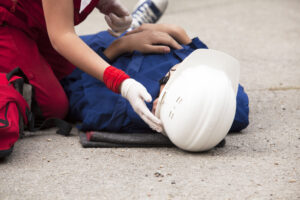The urgent care given to an ill or injured individual is first aid. It might be the only care a person requires in some circumstances.
In other cases, first aid keeps a person alive and prevents their condition from getting worse until paramedics arrive or until they are transferred to the hospital. These are the skills you need to learn and implement in emergencies. Learning about these skills can help save someone’s life.
Formal first aid training is the most excellent way to prepare for these situations. You can learn some simple life-saving techniques in the meanwhile. Getting formal first aid training is ideal for preparing for these situations. You can learn some simple life-saving procedures in the meanwhile.
A Stopped Heart
One of the most crucial emergency medical techniques a person may know is cardiopulmonary resuscitation (CPR). A person may pass away if their heart stops beating. CPR and using an AED may preserve a person’s life when experiencing cardiac arrest. Many public spaces and companies have AEDs on hand. Even if you have no experience, using these first aid tools is simple.
What to do: Start applying chest compressions to the assistance recipient. Push down quickly and forcefully in the middle of the person’s chest with both of your hands. Allow their chest to rise naturally up after compressions. Continue until someone with greater experience shows up.
Bleeding
There are a few fundamentals about how blood functions that will be useful for you to know if someone is hurt and bleeding. You can gauge the severity of the injury from the colour and flow of the blood leaving the body:
Capillaries: The smallest blood vessels, or capillaries, appear to drip while someone is bleeding. Usually, bleeding of this nature ends on its own.
Veins: Blood that flows steadily and has a dark red colour is probably coming from the veins. Mild to severe bleeding can occur with this type of bleeding.
The largest blood vessels and the ones that carry the most oxygen are the arteries. They will bleed bright red if they are hurt.
What to do: Water-rinse the wound. Wrap the wound in gauze or cloth (e.g., towel, blanket, clothing). Direct pressure should stop blood flow and promote coagulation (when blood naturally thickens to prevent blood loss). If you can, raise the area of the body that is bleeding above the person’s head. If the cloth gets wet, do not remove it. The clotting process will be hampered by removing the top layer, increasing blood loss. Instead, if more layers are required, add them. After the bleeding has stopped, cover the wound with a fresh bandage.
Choking:
When food or an object blocks a person’s windpipe (trachea), they can choke. It is a grave incident that has the potential to cause unconsciousness or perhaps death. Choking warning signs include:
Gasping, wheezing, or gagging
Being unable to speak or make noise
Developing a blue face
Squeezing the throat
Extended arms
Looking terrified
What to do: Lean forward while standing behind the individual. Your arms should be about their waist. Place your clenched hand between the victim’s ribcage and navel. With the other hand, take hold of your fist. In five fast thrusts, pull the target’s ribcage backwards and upward with your clenched fist. Continue until you cough up the thing.
Burns
Stopping the burning process is the first step in treating a burn. This could imply:
Removing chemicals
Cutting off the power
Use flowing water to reduce heat
Moving a person inside to avoid the sun or covering them up
There are different kinds of burns. Some include:
First-degree burns only harm the skin’s surface layer and result in redness and oedema. It’s regarded as a minor burn.
Second-degree burn: This type of burn results in blistering, redness, and oedema and damages two layers of skin. If a burn is more than three inches wide, on the face, hands, feet, genitalia, buttocks, or over a significant joint, it is classified as a major burn.
Third-degree burns: These burns impact the deeper skin layers and result in white or blackened, often numb, skin. It is always regarded as a severe burn.
What to do: For several minutes, run cool water over the burned area. Never use ice. Put on a thin gauze bandage. Before covering a minor burn, you can use an ointment like aloe vera. If you require pain medication, take Motrin (ibuprofen) or Tylenol (acetaminophen). Breaking blisters that form is not advised.
A Broken Bone
Until an X-ray can be taken, any injury to your hands, feet, or limbs must be treated as a broken bone. Although broken bones or fractures require medical attention, not all necessitate an immediate hospital trip. First aid measures can help stabilize the bone until you consult a doctor.
What to do: You shouldn’t attempt to straighten the bone. Use a splint and padding to keep the leg immobile, then elevate it. Apply a cold pack to the wound but not to the skin. To prevent tissue injury, place something between the ice and the skin. Ice should be placed in a plastic bag and covered with a shirt or towel before applying if that is all you have. Give the patient painkillers like Advil (ibuprofen) or Aleve (naproxen), anti-inflammatory medicines.
Sprains
An injury to the connective tissues that hold bones, cartilage, and joints together is referred to as a sprain (ligaments). The twisting of a joint most frequently results in sprains when these tissues are overextended or torn. They often occur in the wrists and ankles. A sprain has symptoms that are comparable to fractured bones. To identify the type of injury one has, an X-ray is required.
What to do: Keep the limb as still as you can. Use a cold compress. If it’s safe to do so, elevate the hurt area. For pain, take NSAIDs. Inquire your doctor about any further care you might require for a sprain.
Conclusion
The best way to know what to do if you, a loved one, or even a stranger have a medical emergency is to enrol in official first aid training. First aid attempts are frequently preferable to doing nothing. Sometimes, taking immediate action can save someone’s life.
Read more:
What To Do in 6 Types of Medical Emergencies







